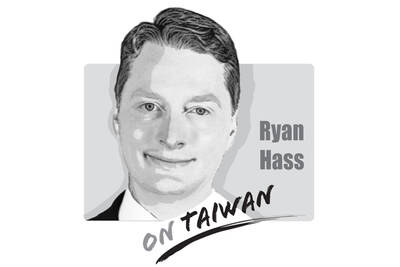A few years ago, COVID-19 dealt a severe blow to the world’s economy and public health. As of April 2023, nearly 7 million people had died from the disease. However, another virus, ancient and far more destructive, is spreading globally — the virus of war. It is propagating through lust for power, obsession with ideology and dictators’ ambitions.
The world is on the verge of the next “pandemic” of this virus. In the first phase, Russia invaded Ukraine, intending to upend the postwar international order. The virus mutated during the second phase, with China promoting a “community with a shared future for mankind,” a seemingly innocuous term disguising a desire to expand totalitarianism. It is penetrating the globe, distorting public recognition.
Russia’s invasion was a wake-up call for the world, with many realizing that peace should not be taken for granted. The postwar world has been eroded by authoritarian regimes such as Russia, China, North Korea and Iran.
The increasing military expenditure of nations around the globe does not imply that the world is heading toward militarism. Instead, it is the cost paid by democracies to maintain peace.
Russian tanks have crossed the border. The Chinese Communist Party (CCP) is using propaganda and economic infiltration to expand authoritarianism. Peace does not fall from the sky. It is a fragile version of civilization that comes at a high cost and must be safeguarded.
Peaceful nations do not pursue war, but must prepare for it to evade it. Increasing military expenses is not for invasion, but to deter aggressive regimes. That is not militarism, but a pragmatic response to totalitarianism.
Taiwan is the CCP’s first target in its expansion of its “community with a shared future for mankind.” Taiwanese did not choose that battleground, but there is no room to hide or to run away.
Four things are needed to maintain peace.
First, the education system must be improved to expose the CCP’s authoritarian nature and its historical atrocities. Young people need to understand the real threat — systematic violence, censorship and governance — behind China’s superficial rhetoric of “peace.”
Second, a social consensus on civil defense must be achieved. National defense should become a civic responsibility, from fighting against cognitive warfare to preparing for natural disasters, and from information literacy to civil defense training. Universal military training should no longer be considered a goal to be reached, but a necessity for survival.
Third, Taiwan must build an alliance with democracies. It is not just about arms procurement, but also participation in international military and technology alliances, and bolstering cooperation mechanisms with the free world, such as the US, Japan and European countries, so that Taiwan can collectively face challenges.
Fourth, Taiwan must take back control of the narrative in the international community for the right to discourse. The nation must reject the false narrative that “Taiwan is an issue,” which is colonial discourse, and tell the world that Taiwan is not an problem, but a solution. The nation is critical to the security of the Indo-Pacific region. Taiwan is the gatekeeper of the free world order.
We do not prepare for war because we want to fight. We do so to avoid becoming a footnote in history, as a dictator’s prey and a short-lived civilization. When faced with a virus, we put on a mask and get vaccinated. When facing the virus of war, we have to bolster our immune system. The world cannot afford to lose Taiwan.
Yu Ming is a registered architect.
Translated by Fion Khan

China has not been a top-tier issue for much of the second Trump administration. Instead, Trump has focused considerable energy on Ukraine, Israel, Iran, and defending America’s borders. At home, Trump has been busy passing an overhaul to America’s tax system, deporting unlawful immigrants, and targeting his political enemies. More recently, he has been consumed by the fallout of a political scandal involving his past relationship with a disgraced sex offender. When the administration has focused on China, there has not been a consistent throughline in its approach or its public statements. This lack of overarching narrative likely reflects a combination
Behind the gloating, the Chinese Nationalist Party (KMT) must be letting out a big sigh of relief. Its powerful party machine saved the day, but it took that much effort just to survive a challenge mounted by a humble group of active citizens, and in areas where the KMT is historically strong. On the other hand, the Democratic Progressive Party (DPP) must now realize how toxic a brand it has become to many voters. The campaigners’ amateurism is what made them feel valid and authentic, but when the DPP belatedly inserted itself into the campaign, it did more harm than good. The
For nearly eight decades, Taiwan has provided a home for, and shielded and nurtured, the Chinese Nationalist Party (KMT). After losing the Chinese Civil War in 1949, the KMT fled to Taiwan, bringing with it hundreds of thousands of soldiers, along with people who would go on to become public servants and educators. The party settled and prospered in Taiwan, and it developed and governed the nation. Taiwan gave the party a second chance. It was Taiwanese who rebuilt order from the ruins of war, through their own sweat and tears. It was Taiwanese who joined forces with democratic activists
Chinese Nationalist Party (KMT) Chairman Eric Chu (朱立倫) held a news conference to celebrate his party’s success in surviving Saturday’s mass recall vote, shortly after the final results were confirmed. While the Democratic Progressive Party (DPP) would have much preferred a different result, it was not a defeat for the DPP in the same sense that it was a victory for the KMT: Only KMT legislators were facing recalls. That alone should have given Chu cause to reflect, acknowledge any fault, or perhaps even consider apologizing to his party and the nation. However, based on his speech, Chu showed